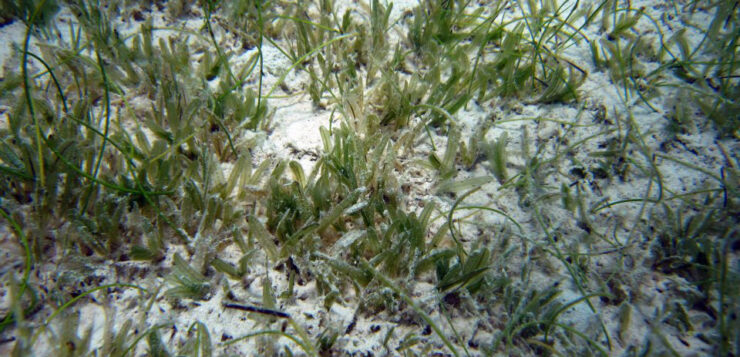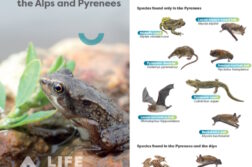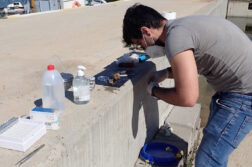A scientific team from 31 institutions, including CEAB-CSIC, has identified the 108 exotic species of animals and plants with the highest risk of having a strong environmental impact on the native ecosystems of Spain in the next ten years.
What are the non-established species in the country with the greatest risk of entering and harming our ecosystems in the next ten years? This is the question answered by the study carried out by 39 specialists from 31 spanish scientific institutions.
The team has evaluated a total of 933 species following the methodology known as “horizon scanning.” In this context, the method consists of obtaining a list of potential species, evaluating their risks in a simplified manner and preparing an ordered and agreed list. As a result, a prioritized list for Spain, which includes 108 species, of which 47 present a “very high” risk of invading ecosystems and 61, a “high” risk.
Many of this species have a long history of invasion and are already found in nearby countries. Among those at greatest risk, a marine plant, Halophila stipulacea, native to the tropics, which entered the Mediterranean through the Suez Canal. Due to its wide environmental tolerance, it has managed to colonize the eastern and central Mediterranean coasts and, for now, has reached Sicily. There is also a beetle (the japonica octopus, which causes great damage to meadows, forests and agricultural plantations) and the nematode worm (the radopholus similis, which feeds on roots and rhizomes, causing the destruction of the area where it feeds). There are only a few examples (you can read the complete list, in this link).
The research has been coordinated by InvaNET. The results have been published in Journal of Environmental Management. Members of this scientific team have also take part in the latest world report on invasive species.
The IPBES world report
The invasive species that supose the most serious threat worldwide are included in the Intergovernmental Scientific-Policy Platform on Biological Diversity and Ecosystem Services (IPBES) report, in which members of the Spanish scientific team have participated.
The document, which was released on September 4, evaluates the trends, causes, impacts and management proposals to address biological invasions around the world.
It concludes that invasive alien species constitute a serious global threat, not only to nature, but to the economy, food security and human health. Furthermore, the results indicate that they have played a key role in 60% of global extinctions of plants and animals.
The report urges greater efforts to be devoted to prevention. In this sense, it highlights the need to involve everyone, from managers to citizens. Remember that the most pristine ecosystems are those that are most resistant to invasions. Therefore, it is necessary to dedicate more efforts to conserve them, to avoid environmental disturbances caused by humans, and to try to keep them in their original state.
About InvaNET
The Thematic Network on Biological Invasions (InvaNET) is funded by the Ministry of Science and Innovation and the State Research Agency, and led by the following research groups:
-Grup d’Investigació en Ecología acuática continental (GRECO), Institut d’Ecologia Aquàtica, UdG
-Centre de Recerca Ecològica i Aplicacions Forestals (CREAF), UAB
-Grup d’Ecologia molecular del bentos marí del Centre d’Estudis Avançats (CEAB-CSIC)
-Departament de Biologia, Bioquímica i Ciències Naturals, Universitat Jaume I
-Biological Invasions Research Group (BioInv), Universidad de Alcalá
-Departamento de Sistemas Físicos, Químicos y Naturales, Universidad Pablo de Olavide
-Estación Biológica de Doñana (EBD-CSIC)
-Instituto de Estudios Sociales Avanzados (IESA-CSIC)
-Global Change Research Group (ICG), IMEDEA-UIB-CSIC
– Instituto de Productos Naturales y Agrobiología (IPNA-CSIC)
Information source: CSIC Andalucia-Extremadura
Article Journal of Environmental Management references: Cano-Barbacil C., Carrete M., Castro-Díez P., Delibes-Mateos M., Jaques J. A., López-Darias M., Nogales M., Pino J., Ros M., Traveset A., Turon X., Vilà M., Altamirano M., Álvarez I., Arias A., Boix D., Cabido C., Cacabelos E., Cobo F., Cruz J., Cuesta J. A., Dáder B., del Estal P., Gallardo B., Gómez Laporta M., González-Moreno P., Hernández J. C., Jiménez-Alfaro B., Lázaro Lobo A., Leza M., Montserrat M., Oliva-Paterna F. J., Piñeiro L., Ponce C., Pons P., Rotchés-Ribalta R., Roura-Pascual N., Sánchez M., Trillo A., Viñuela E. & García-Berthou E. 2023. Identification of potential invasive alien species in Spain through horizon scanning. Journal of Environmental Management 345: 118696. https://doi.org/10.1016/j.jenvman.2023.118696
More details about IPBES report, in this link.





